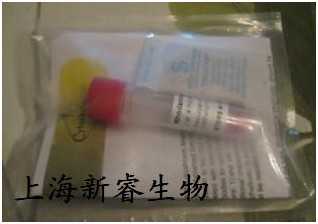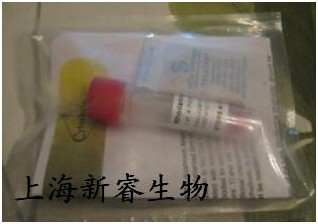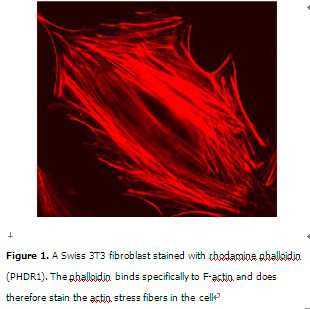
Rhodamine phalloidin罗丹明标记鬼笔环肽
产品名称: Rhodamine phalloidin罗丹明标记鬼笔环肽
英文名称: Rhodamine phalloidin
产品编号: PHDR1
产品价格: 0
产品产地: 美国
品牌商标: Cytoskeleton
更新时间: null
使用范围: null
- 联系人 :
- 地址 : 上海市徐汇区蒲汇塘路11号博大商务楼1307室
- 邮编 : 200030
- 所在区域 : 上海
- 电话 : 138****4547 点击查看
- 传真 : 点击查看
- 邮箱 : 3bio@163.com

产品简介: 罗丹明鬼笔环肽是 F-肌动蛋白的高亲和力探针,由蘑菇毒素制成,与橙色荧光染料四甲基罗丹明 (TRITC) 偶联。 以纳米摩尔浓度使用时,鬼笔毒素是方便的探针,可用于对甲醛固定和打孔的组织切片、细胞培养物或无细胞实验体系中的 F-肌动蛋白进行标记、鉴别和定量。 Product Uses Include · Stain F-actin in fixed cells · Stabilize actin filaments in vitro · Visualize actin filaments in vitro Material The rhodamine phalloidin is provided as a lyophilized powder. When reconstituted with 500 µl methanol, it is at 14 µM (200 x stock). Purity Biological Activity Examples of publications where this product was used: Chen, J., Fabry, B., Schiffrin, E. L. and Wang, N. (2001). Twisting integrin receptors increases endothelin-1 gene expression in endothelial cells. Am J Physiol Cell Physiol 280, C1475-1484. Ezratty, E. J., Partridge, M. A. and Gundersen, G. G. (2005). Microtubule-induced focal adhesion disassembly is mediated by dynamin and focal adhesion kinase. Nat. Cell Biol. 7, 581-590. Gomes, E. R., Jani, S. and Gundersen, G. G. (2005). Nuclear movement regulated by Cdc42, MRCK, myosin, and actin flow establishes MTOC polarization in migrating cells. Cell 121, 451-463. Hsieh-Wilson, L. C., Benfenati, F., Snyder, G. L., Allen, P. B., Nairn, A. C. and Greengard, P. (2003). Phosphorylation of spinophilin modulates its interaction with actin filaments. J. Biol. Chem. 278, 1186-1194. Qian, Y., Baisden, J. M., Cherezova, L., Summy, J. M., Guappone-Koay, A., Shi, X., Mast, T., Pustula, J., Zot, H. G., Mazloum, N. et al. (2002). PKC phosphorylation increases the ability of AFAP-110 to cross-link actin filaments. Mol. Biol. Cell 13, 2311-2322.
Phalloidin's usefulness as a laboratory tool is well established and lies in it's ability to inhibit microfilament de-polymerization. Thus, phalloidin stabilized microfilaments are used as substrates for the identification and characterization of the ever increasing number of microfilament associated proteins. In addition, rhodamine phalloidin can be used for staining the actin cytoskeleton in cells, and also as a fluorescent marker/stabilizer for microfilaments used in motility assays.
In keeping with our policy of providing only the highest quality products, we are now pleased to inform you that Cytoskeleton is offering rhodamine phalloidin at a chromatographic purity of >99%. This is the purest phalloidin commercially available for research use.
We have determined that the microfilament stabilizing property of our product is equal or superior to any other commercially available phalloidins. Microfilaments in 70 nM phalloidin are stable at room temperature for over one week.
Chandhoke, S. K., Williams, M., Schaefer, E., Zorn, L. and Blystone, S. D. (2004). β3 integrin phosphorylation is essential for Arp3 organization into leukocyte αVβ3-vitronectin adhesion contacts. J. Cell Sci. 117, 1431-1441.
